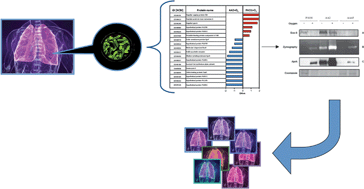Pseudomonas aeruginosa (Pa) is the most common virulent pathogen contributing to the pathogenesis of cystic fibrosis (CF). During bacterial lung colonization, the products of its metabolism are released in the extracellular space contributing to the pathogenic events associated with its presence. To gain insights on the mechanisms involved in the Pa pathogenesis we focused our attention on proteins released by Pa using a MudPIT approach combined with cell biology assays. Conditioned medium (CM) collected under aerobic and microaerobic conditions from Pa clinical strains (in early and late colonization), unlike the laboratory strain, induced expression of IL-8 mRNA in CF airway epithelial cells. We have identified proteins released by clinically relevant Pa strains, focusing on the pro-inflammatory effects as metalloproteases (MMPs). In fact, their expression pattern was associated with the highest pro-inflammatory activity measured in the early clinically isolated strain. The relation was further supported by the result of the analysis of a larger and independent set of Pa isolates derived from sporadically and chronically infected CF patients: 76% of sporadic samples expressed protease activity (n = 44), while only 27% scored positive in the chronically infected individuals (n = 38, p < 0.0001, Fisher's exact test). Finally, looking for a possible mechanism of action of bacterial MMPs, we found that CM from early clinical isolates can cleave CXCR1 on the surface of human neutrophils, suggesting a potential role for the bacterially released MMPs in the protection of the pathogen from the host's response.

You have access to this article
 Please wait while we load your content...
Something went wrong. Try again?
Please wait while we load your content...
Something went wrong. Try again?


 Please wait while we load your content...
Please wait while we load your content...